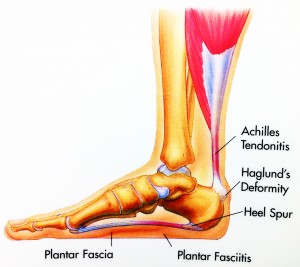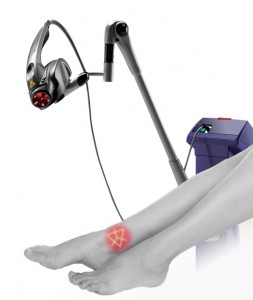 WHAT IS HEEL SPUR SYNDROME?
WHAT IS HEEL SPUR SYNDROME?
Plantar fasciitis, or also know as heel spur syndrome, is an inflammation of the ligament which connects your heel bone to your toes. This ligament is called the plantar fascia. Classic symptoms of plantar fasciitis include pain in the area of the heel near the inside of the foot where the arch of the foot begins. Most individuals feel pain in the morning or after a long period of rest. This is called post-static pain. When you are at rest or not bearing weight on the foot, this time allows the ligament to contract. Therefore when one plants the foot down the ligament will stretch and cause pain. Current thoughts on are that the heel spur that is sometimes associated with plantar fasciitis is not another source of the pain. The spur is simply an extension of bone after the plantar fascia continually stretching and pulling on its insertion on the heel bone.
HOW IS HEEL SPUR SYNDROME DIAGNOSED?
Plantar fasciitis can be diagnosed by your doctor through a thorough history and physical exam. Ancillary testing, like X-rays, MRI, bone scan, or a CT, can be performed additionally to exclude or include any other boney or soft tissue abnormalities. Ultrasound can be used to confirm the diagnosis. Thickening is noted on the ultrasound due to the inflammation and swelling of the ligament. Additionally, blood tests can be performed to diagnose any arthritic or infectious disorders that can be the cause of the heel pain.
WHY DO I HAVE HEEL SPUR SYNDROME?
Plantar fasciitis heel pain syndrome can occur via a myriad of causes. Risk factors such as weight gain, foot type (flat feet, high arched feet), a high level of activity, sports, overuse, improper shoegear, improper support of the feet, trauma, tightness of muscles and daily activities can trigger the classic symptoms. Often, there is no single cause, but a culmination of several risk factors. It is imperative to address all of these factors to treat this condition successfully.
HOW CAN I TREAT THIS PROBLEM?
Evaluating your shoes and switching to a more supportive comfortable shoe is an important step. If the pain continues, decrease your current activity level and start taking anti-inflammatory medication like advil or alleve.

Our office is proud to now offer a groundbreaking laser treatment for heel pain that is clinically proven to be effective. For more information about our Laser Therapy, click here.
WHAT WILL MY DOCTOR DO FOR THIS PROBLEM?
We will evaluate the symptoms and history that you present to us, take an in office X-ray to rule out other possible diagnoses like arthritis, foreign objects, fractures, etc., and we will review our findings and the treatment options that would best suit the severity of the condition.
Treatment options include prescription strength oral nonsteriodal anti-inflammatory medication, laser treatment, physical therapy, stretching exercises, icing, strapping of the foot, custom orthotics (inserts), injections, weight loss programs, evaluation of your shoe gear, night splints, casting, and ultimately surgery.
Conservative treatment is usually very successful and surgery is rarely required. We try to avoid surgery for this problem due to the fact of the anatomical importance of this ligament in the way your foot functions. Altering this ligament has can affect the natural function of the foot.
For those who ultimately need the surgery, we offer minimally invasive endoscopic surgery to release part of the ligament and also ESWT (extra corporeal shock wave therapy) which utilizes sound waves to help alleviate the pain associated with plantar fasciitis. Both methods are FDA approved methods to treat plantar fasciitis and have minimal down time. The decision on which treatment is suited best for an individual patient is made by your doctor based on the details and severity of symptoms.
CAN I PREVENT THIS FROM HAPPENING AGAIN?
Maintaining supportive shoes and also having additional support in your shoes can help prevent this from reoccurring. Weight control will keep added pressure from being exerted on your feet. Continuing stretching exercises will help keep the ligament loose. It is very important to listen to your body and attend to any pain that arises immediately. Chronic pain is harder to treat than acute pain.
If you have any questions, or if you would like to schedule an appointment to see one of our doctors,
give us a call at 310.652.3668.

